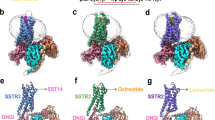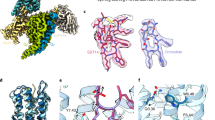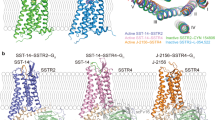Abstract
ONE approach to the problem of producing peptide hormones of high activity for clinical application is to synthesise analogues which are less rapidly inactivated1. In the case of luliberin, it was found that an analogue with an inserted D-amino acid and a blocked C terminal end was 80 times more active than the native peptide in vivo. This correlated well with the decreased lysis of the analogue by neutral endopeptidases2. There is at present considerable interest in utilising somatostatin clinically. This use is drastically limited by its very short half life of less than 5 min (ref. 3). Somatostatin inhibits the release of growth hormone, thyrotropin and prolactin from the pituitary, of glucagon and insulin from the pancreas, and also of gastrin3–5. As a consequence there is considerable incentive to prepare longer acting agonists for use in diabetes, and for treatment of developmental disorders.
This is a preview of subscription content, access via your institution
Access options
Subscribe to this journal
Receive 51 print issues and online access
$199.00 per year
only $3.90 per issue
Buy this article
- Purchase on Springer Link
- Instant access to full article PDF
Prices may be subject to local taxes which are calculated during checkout
Similar content being viewed by others
References
Marks, N., and Stern, F., in Psychoneuroendocrinology (edit. by Hatotani, N.), 276–284 (Karger, Basel, 1974).
Marks, N., and Stern, F., Biochem. biophys. Res. Commun., 61, 1458–1463 (1974).
Brazeau, P., Vale, W., Rivier, J., and Guillemin, R., Biochem. biophys. Res. Commun., 60, 1202–1207 (1974).
Koerker, D. J., et al., Science, 184, 482–483 (1974).
Arimura, A., Sato, H., Dupont, A., Nishi, N., and Schally, A. V., Science, 189, 1007–1009 (1975).
Marks, N., and Stern, F., FEBS Lett., 55, 220–224 (1975).
Brown, M., Rivier, J., Vale, W., and Guillemin, R., Biochem. biophys. Res. Commun., 65, 752–756 (1975).
Evered, D. C., et al. Lancet, i (7918), 1250 (1975).
Rivier, J., Brown, M., and Vale, W., Biochem. biophys. Res. Commun., 65, 746–751 (1975).
Benuck, M., and Marks, N., Biochem. biophys. Res. Commun., 65, 153–160 (1975).
Marks, N., and Pirotta, M., Brain Res., 33, 565–567 (1971).
Marks, N., Galoyan, A., Grynbaum, A., and Lajtha, A., J. Neurochem. 22, 735–739 (1974).
Koch, Y., Baram, T., Chobsieng, P., and Fridkin, M., Biochem. biophys. Res. Commun., 61, 91–103 (1974).
Camargo, A. C. M., Shapanka, R., and Greene, L. J., Biochemistry, 12, 1838–1844 (1973).
Vale, W., Grant, G., and Guillemin, R., in Frontiers in Neuroendocrinology (edit. by Ganong, W. F., and Martini, L.), 375–413 (Oxford University Press, New York, 1973).
Author information
Authors and Affiliations
Rights and permissions
About this article
Cite this article
MARKS, N., STERN, F. & BENUCK, M. Correlation between biological potency and biodegradation of a somatostatin analogue. Nature 261, 511–512 (1976). https://doi.org/10.1038/261511a0
Received:
Accepted:
Issue Date:
DOI: https://doi.org/10.1038/261511a0
Comments
By submitting a comment you agree to abide by our Terms and Community Guidelines. If you find something abusive or that does not comply with our terms or guidelines please flag it as inappropriate.



